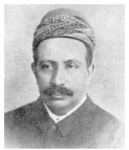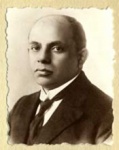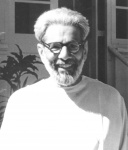User:SysopJ/My sandbox: Difference between revisions
No edit summary |
No edit summary |
||
| Line 1: | Line 1: | ||
== Zoroastrians and the Theosophical Society == | |||
== | === Early history === | ||
=== Prominent Zoroastrian Theosophists === | |||
<gallery widths="130px" heights="150px" perrow="5"> | |||
File:N._D._Khandalavala.jpg|<center>|N. D. Khandalavala</center> | |||
File:B._J._Padshah.jpg|<center>Burjorji J. Padshah</center> | |||
File:Col_Ghadiali.jpg|<center>Dinshah P. Ghadiali</center> | |||
File:B_P_Wadia_1.jpg|<center>B. P. Wadia</center> | |||
</gallery> | |||
'''[[N. D. Khandalavala]]''' (Khān Bahādur Navroji Dorabji Khandalavala) was a provincial judge who greatly assisted the [[Founders]] after becoming a member in 1879. He corresponded with [[H. P. Blavatsky|Madame Blavatsky]], who disclosed to him important information about the Mahatmas and other matters. | |||
He | '''[[K. M. Shroff]]''' was a highly educated Parsi member in Bombay. In 1874 he lectured in the United States, and Shroff joined the TS by corresponding with the Founders before they left New York, making him one of the earliest Indian members. He was vice president of the Bombay Branch from 1882 to 1885, a member of the TS General Council, and a major speaker at the 1882 convention. Col. Olcott referred to him as “the all-accomplishing Mr. K. M. Shroff.” Certainly, he was persuasive and energetic; and he helped to establish the Homeopathic Charitable Dispensary and Bombay Veterinary College and Hospital, working with Tukaram Tatya. Shroff testified in support of HPB in the [[The Vega Incident|Vega incident]]. In 1883 he become editor of the Jam-e-Jamshed daily newspaper published in Gujarati and English. | ||
'''[[Sorabji J. Padshah]]''' (1856-1927) was another Parsi who joined the Society in 1880. He traveled with the Founders on their first trip to Ceylon, and served as Assistant Recording Secretary and on the General Council. In 1881 he received [[Mahatma Letter to Padshah - LMW 2 No. 77|an encouraging letter from Master K.H.]], but after a few years he lost interest in Theosophy. | |||
His younger brother’’’ [[Burjorji J. Padshah]]’’’ (1864-1941) was a mathematics professor trained at Cambridge. He exerted great influence on the development of India’s largest conglomerate, the Tata Group, and on establishment of the Indian Institute of Science. He practiced Theosophical principles his whole life, abstaining from meat, leather, alcohol, and tobacco and advocating for animal welfare. | |||
A later Zoroastrian was '''[[Dinshah Ghadiali|Dinshah P. Ghadiali]]''' (1873-1966), who was born in India but became a naturalized American citizen. His interests in medicine and electrical engineering led to patenting the Spectro-Chrome device for light therapy. He was a member of the Theosophical Society from 1891 to 1966, and published at least 16 books. | |||
'''[[B. P. Wadia]]''' ........... | |||
[[Category:TSWiki categories]] | |||
These practitioners of Zoroastrianism were Theosophists or were significant to the Theosophical movement. Two culturally distinct groups of Zoroastrians exist in India: '''Parsis or Parsees''', who descended from Persians who emigrated to India in the 8th and 10th centuries CE; and '''Iranis''', who made a similar migration many centuries later. | |||
=== Adyar headquarters === | |||
International Theosophical Society president [[Radha Burnier]] lived at ‘’’Parsi House’’’ at the headquarters estate in Adyar. That [[Adyar (campus)|campus]] also features a Zoroastrian Temple and symbols of Zoroastrianism in the main hall. | |||
=== | |||
[[ | |||
[[ | |||
Revision as of 21:42, 7 September 2023
Zoroastrians and the Theosophical Society
Early history
Prominent Zoroastrian Theosophists
-
N. D. Khandalavala
-
Burjorji J. Padshah -
Dinshah P. Ghadiali -
B. P. Wadia
N. D. Khandalavala (Khān Bahādur Navroji Dorabji Khandalavala) was a provincial judge who greatly assisted the Founders after becoming a member in 1879. He corresponded with Madame Blavatsky, who disclosed to him important information about the Mahatmas and other matters.
K. M. Shroff was a highly educated Parsi member in Bombay. In 1874 he lectured in the United States, and Shroff joined the TS by corresponding with the Founders before they left New York, making him one of the earliest Indian members. He was vice president of the Bombay Branch from 1882 to 1885, a member of the TS General Council, and a major speaker at the 1882 convention. Col. Olcott referred to him as “the all-accomplishing Mr. K. M. Shroff.” Certainly, he was persuasive and energetic; and he helped to establish the Homeopathic Charitable Dispensary and Bombay Veterinary College and Hospital, working with Tukaram Tatya. Shroff testified in support of HPB in the Vega incident. In 1883 he become editor of the Jam-e-Jamshed daily newspaper published in Gujarati and English.
Sorabji J. Padshah (1856-1927) was another Parsi who joined the Society in 1880. He traveled with the Founders on their first trip to Ceylon, and served as Assistant Recording Secretary and on the General Council. In 1881 he received an encouraging letter from Master K.H., but after a few years he lost interest in Theosophy. His younger brother’’’ Burjorji J. Padshah’’’ (1864-1941) was a mathematics professor trained at Cambridge. He exerted great influence on the development of India’s largest conglomerate, the Tata Group, and on establishment of the Indian Institute of Science. He practiced Theosophical principles his whole life, abstaining from meat, leather, alcohol, and tobacco and advocating for animal welfare.
A later Zoroastrian was Dinshah P. Ghadiali (1873-1966), who was born in India but became a naturalized American citizen. His interests in medicine and electrical engineering led to patenting the Spectro-Chrome device for light therapy. He was a member of the Theosophical Society from 1891 to 1966, and published at least 16 books.
B. P. Wadia ........... These practitioners of Zoroastrianism were Theosophists or were significant to the Theosophical movement. Two culturally distinct groups of Zoroastrians exist in India: Parsis or Parsees, who descended from Persians who emigrated to India in the 8th and 10th centuries CE; and Iranis, who made a similar migration many centuries later.
Adyar headquarters
International Theosophical Society president Radha Burnier lived at ‘’’Parsi House’’’ at the headquarters estate in Adyar. That campus also features a Zoroastrian Temple and symbols of Zoroastrianism in the main hall.



